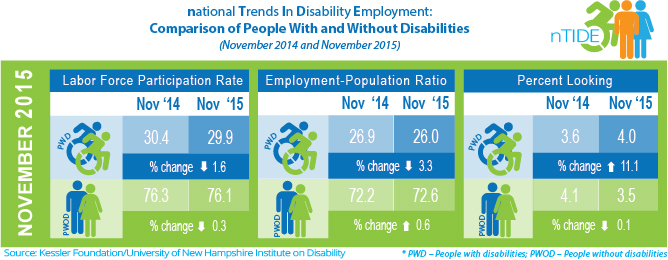nTIDE November 2015 Jobs Report: Employment Continues to Drop for People with Disabilities; New Uber Project Strives to Remove Transportation Barriers
Kessler Foundation and University of New Hampshire release November nTIDE Report – Monthly Update
WEST ORANGE, N.J. – December 4, 2015. For the third consecutive month, fewer Americans with disabilities are working, while the labor force holds steady for people without disabilities, according to today's National Trends in Disability Employment – Monthly Update (nTIDE), issued by Kessler Foundation and University of New Hampshire’s Institute on Disability (UNH-IOD). To help minimize barriers to employment, Uber is partnering with Community Options to increase options for accessible transportation in a new pilot project.
In the Bureau of Labor Statistics’ Jobs Report released Friday, December 4, the employment-to-population ratio for working-age people with disabilities decreased from 26.9 percent in November 2014 to 26.0 percent in November 2015 (down 3.3 percent; 0.9 percentage points). For working-age people without disabilities, the employment-to-population ratio increased from 72.2 percent in November 2014 to 72.6 percent in November 2015 (up 0.6 percent; 0.4 percentage points). The employment-to-population ratio, a key indicator, reflects the percentage of people who are working relative to the total population (the number of people working divided by the number of people in the total population multiplied by 100).
“This is the third consecutive month where we are seeing a worsening of employment situation for people with disabilities,” according to John O’Neill, Ph.D., director of employment and disability research at Kessler Foundation. “This contrasts sharply with the first eight months of this year, where we saw gains made by people with disabilities that outpaced gains made by people without disabilities.”
The labor force participation rate of people with disabilities also decreased from 30.4 percent in November 2014 to 29.9 percent in November 2015 (down 1.6 percent; 0.5 percentage points). For people without disabilities, the labor force participation rate also decreased from 76.3 percent in November 2014 to 76.1 percent in November 2015 (down 0.3 percent; 0.2 percentage points). The labor force participation rate is the percentage of the population that is working or actively looking for work.
“The declines we are seeing this month are still not as severe as two months ago, and about the same as last month. We are still hopeful that the employment outlook for people with disabilities will return to what we saw earlier in the year,” said Andrew Houtenville, Ph.D., associate professor of economics at UNH.

Initiatives are underway to remove barriers to employment for people with disabilities. According to the 2015 Kessler Foundation National Employment and Disability Survey, more than a quarter of Americans with disabilities report a lack of transportation as a barrier to finding employment. To improve access to transportation, Kessler Foundation awarded a grant to Community Options to launch Autobility, a one-year pilot project. Community Options will partner with Uber Technologies and human services agencies in Pittsburgh, Pennsylvania to increase the supply of wheelchair-accessible vehicles, educate people with disabilities on transportation options and develop a simple and expedient process for booking accessible rides.
“The Autobility project has the potential to bring a new level of independence and self-sufficiency to people with disabilities,” said Elaine E. Katz, MS, senior vice president of grants and communications at Kessler Foundation. “Uber has expedited transportation for so many consumers, as they can request a ride via smartphone at any time and location and be picked up by nearby drivers. It’s time to bring the same convenience to individuals with disabilities. Now, they will have equal opportunities to go to work and participate in other activities. Once we build a successful model, Autobility may be replicated across the United States.”
In November 2015, among workers ages 16-64, the 4,097,000 workers with disabilities represented 2.9 percent of the total 141,160,000 workers in the U.S.
“The statistics in nTIDE are not seasonally adjusted,” noted Dr. O’Neill. “Because disability employment data have been collected for so few years, more time is needed for seasonal trends to become evident.”
The next nTIDE will be issued on Friday, January 8, 2015.
NOTE: The statistics in the National Trends in Disability Employment – Update are based on Bureau of Labor Statistics numbers, but are NOT identical. They have been customized by the University of New Hampshire to efficiently combine the statistics for men and women of working age (16 to 64).
nTIDE is funded, in part, by grants from the National Institute on Disability, Independent Living and Rehabilitation Research (NIDILRR) and Kessler Foundation.
About Kessler Foundation
Kessler Foundation, a major nonprofit organization in the field of disability, is a global leader in rehabilitation research that seeks to improve cognition, mobility and long-term outcomes, including employment, for people with neurological disabilities caused by diseases and injuries of the brain and spinal cord. Kessler Foundation leads the nation in funding innovative programs that expand opportunities for employment for people with disabilities. For more information, visit KesslerFoundation.org.
About the Institute on Disability at the University of New Hampshire
The Institute on Disability (IOD) at the University of New Hampshire (UNH) was established in 1987 to provide a coherent university-based focus for the improvement of knowledge, policies, and practices related to the lives of persons with disabilities and their families. For information on the NIDILRR-funded Employment Policy and Measurement Rehabilitation Research and Training Center, visit http://www.ResearchonDisability.org.
For more information, or to interview an expert, contact:
Lauren Scrivo, 973.768.6583, [email protected]
Carolann Murphy, 973.324.8382, [email protected]